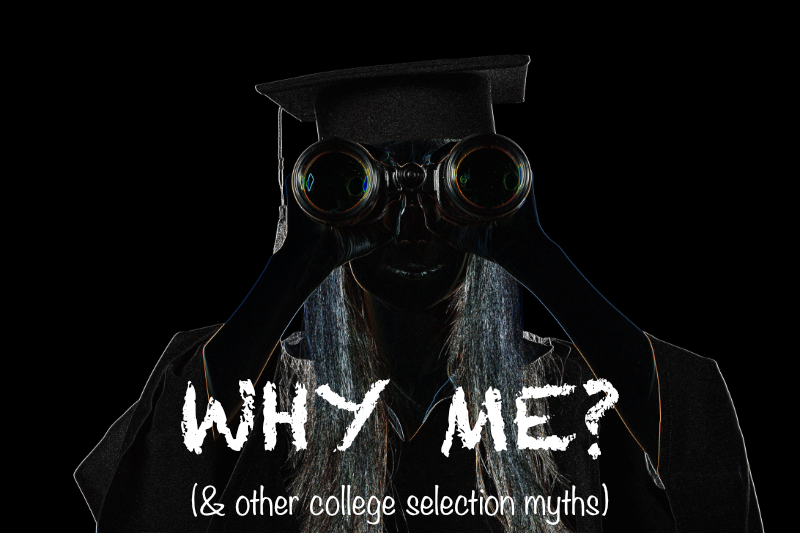
In making the most significant choice of your life, to date, students, and often their well-meaning, but modern-process-unfamiliar parents, will make two huge mistakes:
- Beginning with assumptions, rather than knowledge of facts;
- Worrying about numbers, the “Why Me?” worry.
Unless someone who has worked in admissions has let you in on the secret of “cohorts,” the things about each student that the school needs to generate the kind of student body that is both conducive to the education, and quality of life, on campus, then you’re already looking a picking schools without one of the primary facts:
You have value to a school, especially with arts skills, aside from just your cash value as a warm body.
This is truest at small and medium schools that don’t admit thousands of students annually. The bigger the school, the less that your uniqueness tends to matter.
Every Fall, we hear students, and their parents, spout the myths:
- “I have to look only at state schools. I can’t afford the tuition.”
- “There are so many people who apply to that school, (I/you) won’t get in.”
- My [college plan here] limits me to specific schools.
Replacing Assumptions With Facts
Many fail, miserably, in the process of making this huge life choice, if they stick with the ten most common mistakes in picking a school. The yardstick for what makes a great school, from an okay one, for you, is in the research that you need to do for EVERY school.
The Affordability Myth
Neither you, nor the school itself, can realistically predict your value to ANY school, in any year, until the admissions process is complete. So, looking at the “list” price of a college, or using their high-high-end leaning “cost calculator,” really means a sum total of nothing.
Here’s why:
- Schools HAVE to “staff” their student body with a lot of needs, well beyond the race, gender, and socioeconomic status cohorts that they like to tell you about.
- The more that you can tell a college about yourself, primarily through your essay, and your resumé given to your guidance counselors, it gives a college admissions team a deep understanding of your cohort values, how you “plug in” to their grid. That helps make you more desirable. Aside from obvious “value” skillsets, like athletes, and musicians, they need many, many more:
- Different personality types;
- Special interests, from rock collectors to Quidditch players;
- Geographical background – Other states, other countries;
- Skillsets – Leadership, out-of-the-box thinking, etc.
Many schools don’t give “merit” aid, but, at the end of the day, they still need to fill the holes in their student body.
Don’t Ask, Don’t Get
You can’t even be considered for money, for any school that isn’t prepaid/automatic state merit program, unless you apply. Truly, you can’t succeed at ANYTHING, until you give someone the ability to say YES to you, which means that they also could say “NO.” They’ll never have the option if you don’t introduce yourself.
Are you any worse off for taking a shot at your dreams, at any time, than having NEVER applied yourself, taken the shot at all?
Let them say YES.
The “I Can’t Afford [SCHOOL/SCHOOL TYPE]” Myth
Once you apply, you wait. Then you get in, or you don’t, or you’re “deferred.”
You won’t get your best aid package on the first try. They will send “carrots” with your acceptance letter that try to entice you, with as little as they feel that they have to put out, to bring you to their school.
“Bobby, we welcome you to Brown. We’re delighted to provide you with The Janitor’s Super Special Scholarship of $6,000…”
You will get your financial aid package April 1st. You won’t know, even then, if you can afford it, because schools don’t know how valuable you will be to them until we get to week four. So DO NOT MAKE DECISIONS until week four, April 29th.
No one is going to take away your slot until May 1st, unless they have an earlier deadline, which virtually no school does.
If you can stick with the haggling process, between the close of admissions season, April 1, and HANG ON, and keep pressing for money weekly, until April 30th, right before the May 1 decision deadline, you may find that you have several options, other than the ones that your original approach, to “suppose” that you can only go to certain schools, with obvious price tags, were your only choices.
Why?
Students pull out of the process, and go to other schools. The Admissions Office’s job was to admit you. The FinAid office’s job is to RETAIN enough students that fit the campus’ many cohort needs.
You may not have been a “10” on their desirability list on week one. You may be worth a lot more money on week four, if they lose other people whom they were looking at.
Read up on how the haggling works. It will make you feel better. Many students, who start with big financial gaps, end up with the ability to go to some schools that their “perception” would have kept them from applying to in the first place.
The “Why Me?” Myth
Self-doubt. It comes either from the fear of rejection, or the fear of success.
“What will I DO if Juilliard admits me? I’m not Juilliard.”
If Juilliard admits you, then you’re Juilliard.
So, instead of listening to those dark inner voices of doubt, doom, and gloom, ask yourself a different question:
Why (Not) Me?
You assume that you aren’t all that unique. By doing so, you then don’t apply to places, which deny them the possibility of telling that, for them, at least, you ARE that unique.
If you go about life always selling yourself short, you will absolutely live up to those lowered expectations. You will always wonder, though, what you could have done, had you at least taken a shot at a few places, not all, that are within your reach, in terms of your academics, and testing, based on the Naviance, or similar, scattergrams that you can see FOR YOUR SCHOOL.
This will also dispel the national SAT/ACT averages that the colleges post like scarecrows on their websites for US News and other ranking systems to use as meaningless yardsticks. The truth of what any college or university will accept is not the national average, but the scattergrams for YOUR SCHOOL. That’s how you’re usually evaluated.
Getting a “no” from a college is no worse than having never applied. Getting a “yes,” though is transformative. Even if you can’t afford, ultimately, to attend a Princeton, YOU GOT IN. You not only have that moment of pride, but it may, down road, for graduate school, become a goal to try to be there, with that faculty, in your major, when you complete undergraduate education.
The “So Many Applicants” Myth
Another way that students, and their families, often psych themselves out, is to look at the number of people applying to the school.
“There’s 40,000 people applying for Columbia. You’ll never get in.”
If you believe that, then it’s true. You aren’t giving them the ability to pluck you out of the 40,000 pool, which you have JUST AS MUCH opportunity to have happen as anyone else who applies.
The “You Can Go Anywhere for Your Undergrad” Myth
Where you go to school matters. A lot. It will define how hard, or easy your life pathway, in your field(s) of interest, are going to go.
So research your choices of major departments WELL. We’re looking for:
- Mafia – The best faculty, and alumni network with a national, preferably international, footprint, that is going to help keep us employed, and alive through decades that as The Economist has pointed out, will be where there is MASSIVE human job loss to AI and Robotics, especially in areas once deemed as “high earning,” like medicine, pharmacy, law, accounting, engineering, and computer science.
- The Grad School dilemma for undergrads – As larger universities, trying to cram in more and more students on low-cost, prepaid, and “free” tuition receive no help from either their state, or the federal government, the number of people who teach higher ed may be rising, but the number of “full” graduate professors is not. Schools hire cheaper labor, more Adjunct, Associate, and Lecturer-level faculty. More students entering the system. More needing higher degrees to survive in a future where massive unemployment is a certainty, and fewer people to confer those degrees. So, in your UNDERGRADUATE education, schools that offer Capstone (Thesis) projects increase your likelihood of continuing to work in fields that will be more automation-proof.
The “Some Choices in My List Don’t Matter” Myth
Do not, out of the naïveté of thinking that EVERY school that you pick on your final list doesn’t matter. That “The bottom of my list I’m not really going to” assumption.
You need to apply to 6-8 schools in high-audition requirement arts, 8-12 schools in portfolio/low-audition and academic schools.
Apply to three? You could get into none. There is no such thing as a “safe” school. The only “safe” schools are ones that, based on admissions, NO SCATTERGRAM, are pursuing students at your school, but students, in past years, have been admitted, and turned that school down. Those colleges are actively recruiting your school. They have a desire to attract students like you. That is particularly safe.
Is a school where, with a state program like “Bright Futures” that will pay for 75%-100% of your tuition “safe?”
That would depend on your RESEARCH. Is the curriculum, and the faculty, and alumni that are going to be your MAFIA, after school, what you need to get off into life in a world that is looking at a collapsing global jobs market?
Every choice that you make MATTERS. Hugely.

Do your homework on each school. Look at the Naviance, or other scattergrams, to determine FOR YOUR SCHOOL, what your chances of getting in are. Every “Yes” dot on the scattergram got in. So even if you’re one of those “dots” on the outside, but there were “Yes” answers, you have a shot. Take it!
Then, with a few “yes” answers, haggle away to see which schools want you badly enough to make a good deal.
You can afford more than you think,and you can radically change your life path for the better if you DON’T PANIC!!
